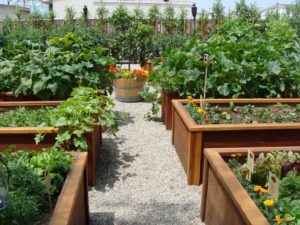
In addition to compatibility in color and other decorative features, plants should have similar requirements for light, moisture, and soil. Most vegetable crops like light and grow well in fertile, moist soils, it is no accident that for a long time in the garden they occupied the most open, flat places with the best soils.
But in addition to lighting lovers: tomatoes, peppers, pumpkins, cabbage, among the ornamental vegetables there are species that prefer partial shade: Physalis alkekengi, Ajuga reptans, Myrrhis odorata, rhubarb, as well as species that thrive only in the shade: Pteridium aquilinum, Earth ivy, Bird cherry and Allium victorialis.
Ramsons prefers partial shade(the image above).
The water requirements of plants are also different. It is known that water-loving cabbage needs not only frequent, but also abundant watering. On the contrary, tomatoes can be watered 1-2 times a week even in hot, dry summers during the ripening of the crop. Many herbs – Rue, Thyme, Wormwood, Polygala, Teucrium Polyum-do not need watering, and too much moisture is harmful for them.
Thyme does not need watering.

Different requirements for plants and fertilizers: some of them (cabbage, Pepper, Sunflower, Carrot, chard) are decorative only on fertile soils, while others (Pimpernel saxifrage, Allium saxtile, Tanacetum) are satisfied with poor, sandy or stony soils.
Chard grows well in all types of soils with a neutral or slightly alkaline reaction, except for heavy loams, floating.

Therefore, do not plant plants with different requirements in the same garden, they will feel depressed, grow poorly, bloom poorly, bear fruit and wither . If space allows, it is easiest to take separate beds for each crop selected for planting. But if you want mixed beds and flower beds, you will have to work hard and choose from a wide variety of only those plants that can grow together.
In addition to the general basic requirements of plants for light, irrigation, and soil, it is equally important to adapt some plants to the root secretions of others, as well as to their own. For example, hyssop and fennel do not tolerate the proximity of many plants. Not a tomato plant next to Brassica rapa. This is due to the mutual effect on the root and leaf secretions of plants in the form of phytoncide and other volatile substances.
Fennel does not tolerate neighborhood.

Don’t stop at the same place every year to grow the same crops. Chard and spinach are the most sensitive to their own root secretions. Less sensitive are Cucurbitales plants, as well as Carrots, Celery, Peas, and Parsley. Corn, Onions, and Beans are almost insensitive to their own secretions.
When placing plants, take into account the best predecessors, observe the alternation of crops from year to year, because vegetables get a lot of nutrients from the soil, but different crops have different amounts and composition. Alternation of plants prevents the development of diseases, pests and weeds. To navigate the sequence of plants on your site, the annual plan for their placement should be written in a notebook.
In mixed plantings, it is good to take into account the protective properties of some plants, their ability to deter pests and reduce the risk of diseases. So, horseradish planted next to potatoes increases its resistance to diseases.
Horseradish-potato defender.

However, there are plants that contribute to the spread of diseases. So, sorrel favors the development of phytophthora. Some plants emit substances that are harmful to insect pests of other plants.
Sorrel on the side of Phytophthora.

In addition, some plants: Basil, Lavender, common sage, Spinach, contain the biological substance saponin, which contributes to the more intensive development of other plants.
Lavender stimulates the development of neighbors.

Here is the answer to the question: to determine the optimal placement of vegetable and flower plants in mixed plantings, you need to find out their environmental requirements, make a table from a sample of planting species, indicating their relationship to light, moisture, soil, as well as the compatibility of root secretions; evaluate their compliance with the intended growing conditions in the garden, and then, after carefully reading, exclude plants that stand out from the list.




Leave a Reply